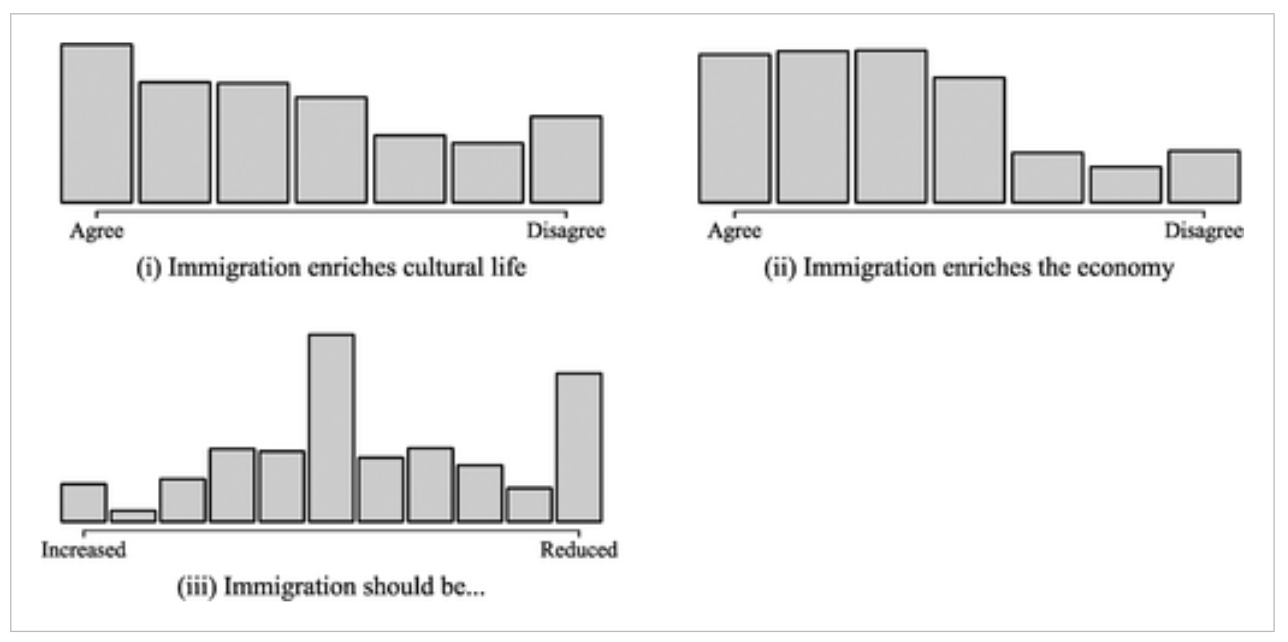| 7 mins read
Calls for a return to the centre ground are a perennial feature of British politics. In crisis after crisis, we are presented with misty-eyed evocations of an era when consensus reigned, when leaders from different ideological backgrounds were united around a shared policy platform, when the virtues of moderation were properly respected. But these dreams of the centre ground all depend on a deeper assumption that most people hold moderate political beliefs, with a few extremists at either end.
Despite its vast influence, this ‘centre ground hypothesis’ has rarely been tested empirically. Instead, it has slipped into the taken-for-granted background of political discourse. The most famous application of this hypothesis has been with regards to the ideological divide between left and right. Political scientists measure this ideological position in two ways: one is by asking people to place themselves somewhere on a scale between left and right; the other is to calculate an index based on a series of questions about their economic beliefs. Unfortunately, these two approaches produce very different empirical results. When academics calculate people’s left-right score for them, the British population is heavily skewed towards left-wing economic positions—clearly violating the centre ground hypothesis. But, when given a scale and the freedom to place themselves on it, nearly 20 per cent of people put themselves dead centre. In fact, the graph in the right panel of Figure 2 is a clear example of the beautiful bell curve that makes the hypothesis so seductive.

Figure 2: Left-right attitudes in Britain, British Election Studies Internet Panel (BESIP), June 2020
What should we make of this contradictory evidence? One response is to say that the centre ground hypothesis is true and that, somewhere in the calculation of the left-right index, academics have lost touch with reality. But given how many different things people can mean by ‘left’ and ‘right’, it is difficult to read much from that second graph of left-right attitudes beyond the fact that, when given a scale, people like to put themselves at the centre of it. On the other hand, a central problem with the index in the left-hand panel is that it struggles to accurately identify ‘moderates’. For instance, in the British Election Studies (BES) data analysed here, 27 per cent of respondents crossed between left and right on at least one of the questions, and their inconsistency is interpreted as moderation, even when they have radical right or left perspectives on certain issues. This inflates the number of ‘moderates’ in the data, creating a ‘moderate middle’ out of normal inconsistency.
The true shape of public opinion
A cleaner test of the centre ground hypothesis can be conducted if we turn to people’s attitudes to individual political issues. Looking at economic and fiscal policy, evidence for the centre ground hypothesis is hard to find: people are skewed in favour of increasing taxes, against austerity, and in favour of reducing the government deficit. Our attitudes towards redistribution also violate the centre ground hypothesis with as many people agreeing very strongly as put themselves in the middle, and an almost as large at the opposite end saying that the government should not worry about equalising incomes at all.

Figure 3: Attitudes to fiscal policy (BESIP, June 2020)
On immigration—that all-consuming totem of twenty-first century British politics—the results don’t hold much promise for the centre ground hypothesis either. As Figure 4 shows, there is little evidence of people holding moderate opinions, with a few extremists at each end. Instead, they reveal widespread agreement with the claim that immigration enriches British culture and the British economy. And, when asked directly whether immigration should be increased or reduced, almost as many people chose the extreme anti-immigration position, as put themselves in the centre.

Figure 5: Attitudes to immigration (BESIP, June 2020)
There are similar results across social and international affairs. We find opposing groups and strong consensuses, but little evidence to support the centre ground hypothesis. If most people really are moderates, they're doing a good job of hiding it.
The virtuous middle
Although evidence supporting the centre ground hypothesis is hard to come by, assumptions about the virtuous middle have proved equally hard to shake. In large part this is because many people still assume that there ought to be a broad moderate consensus on all political questions, while anything which deviates from it is the result of ‘fake news’ or ‘populist’ distortion. This is a manifestation of the more general liberal dream of a political system free from conflict and a status quo that commands widespread consent. But, that dream is dangerous, and fuels liberalism's most egregious and conspiratorial tendencies: People would agree with us, if only they weren’t misled and misinformed. We know what people would want, even if it’s not what they say they want.
Common Sense
Abandoning the simple curves of the normal distribution is a vital antidote to the hidden ideological assumptions and political narratives that make up the centre ground hypothesis. But it also means admitting our own ignorance more explicitly: there’s no reason to presume that common sense in a particular area will take on a particular shape, or that the silent majority is made up of moderates. Instead, we are left with the call to examine the complex, but concrete, patterns of common sense as they evolve from one moment to the next. This may not provide us with immediate strategic guidance. But it will force us to recognise the true shapes of public opinion and to start addressing the gaps in its theorisation.
Need help using Wiley? Click here for help using Wiley







